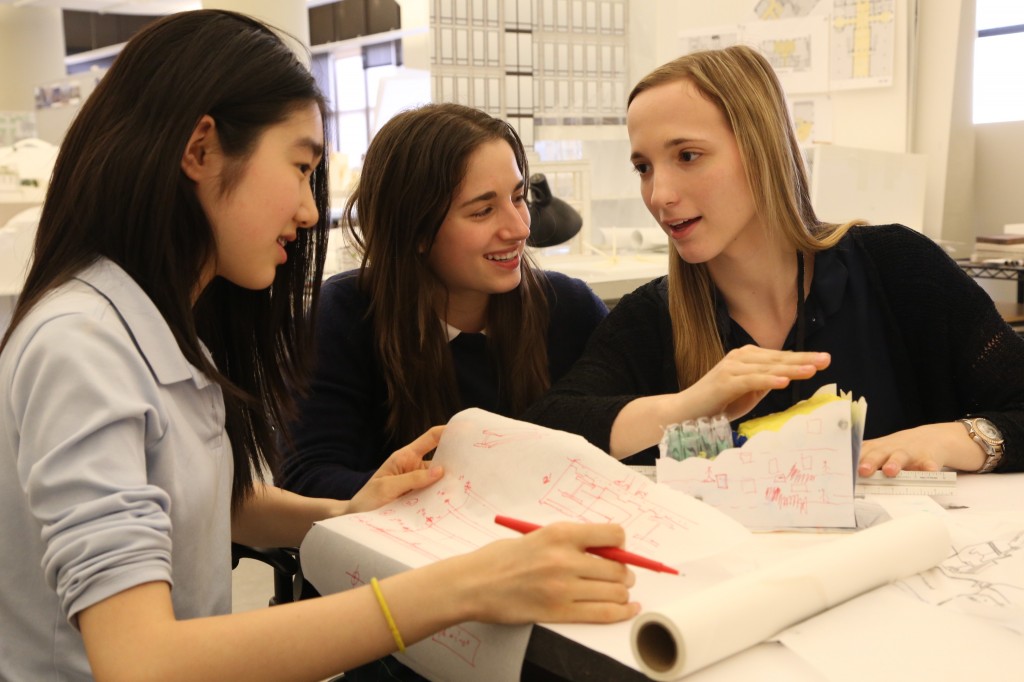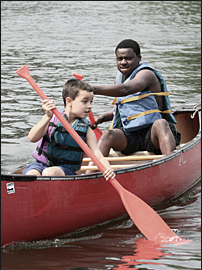 By Kelly Bird Pierre
By Kelly Bird Pierre
Kelly Bird Pierre is the former Director of Enrollment and Admissions, K–12 at The Hewitt School and current Lower School Principal at Friends' Central School She taught in co-ed lower school classrooms for 13 years before working in admissions at a single-sex school.
What is the value-added in a girls’ school? It is an intentional commitment to expand the range of what is possible for a girl. The gift that a single sex school gives a girl is space; space to explore, to experiment, to speak, to believe, to strengthen and to see herself reflected in the larger world. Our girls are prepared to do anything, but told that they need not do everything.
Our kindergarten girls walk into classrooms where each lesson and space is designed with their success in mind. The range of possibilities for the girls is immediately greater. As a former colleague observed, “At Hewitt, the block area is always open for girls.” Although many teachers in co-ed classrooms are careful to make things equitable, there are gender differences in how children play. The guideline that, “There must be two girls and two boys in the block area” may still not encourage girls to join because they don’t like the way the boys play with the blocks. There is a joy in building something as big as you can and knocking it down that is fun for some boys and not fun for some girls. Having spaces that are solely for them allows girls to move freely within their classroom and the school and to experiment more broadly within the program.
Unfortunately, we still live in a world in which voices of female leadership are scarce. In 2012 only 14.3% of women held Executive Officer positions in Fortune 500 companies.1 In my own classroom, I observed that boys will generally raise their hand before they think of their answer and girls often think of their answer before they raise their hand. Inherently, this is going to lead to more boys being called on unless a teacher waits…and waits. This only intensifies in co-ed settings as girls become more self-conscious of their changing bodies and sense of themselves, and, consequently, sometimes defer to boys even when they have the answer. Next time you are in a classroom, I encourage you to look at whose hands are in the air and who is talking. In a single sex school there is less competition for airspace, and quieter girls know there is room for their voices.
 Of course, many of our daughters will gravitate toward pink and Barbies no matter how hard we try to fight the gender stereotypes because we are immersed in a culture where gender stereotypes still thrive. The same is true for the subjects towards which girls and boys gravitate. We can look at how many women are represented in the STE2M (Science, Technology, Engineering, Environmental Sustainability and Math) fields to see this is true. Many boys expect to be good at math, which is half the battle of success. As my own second graders matured throughout the year, the girls would watch more boys join the enrichment math work at lunchtime, and my strongest girls would start to shy away from the work time. I worked hard to counteract girls’ too often tacit assumption that they should not be good at math. At a girls’ school, girls are the best at everything.
Of course, many of our daughters will gravitate toward pink and Barbies no matter how hard we try to fight the gender stereotypes because we are immersed in a culture where gender stereotypes still thrive. The same is true for the subjects towards which girls and boys gravitate. We can look at how many women are represented in the STE2M (Science, Technology, Engineering, Environmental Sustainability and Math) fields to see this is true. Many boys expect to be good at math, which is half the battle of success. As my own second graders matured throughout the year, the girls would watch more boys join the enrichment math work at lunchtime, and my strongest girls would start to shy away from the work time. I worked hard to counteract girls’ too often tacit assumption that they should not be good at math. At a girls’ school, girls are the best at everything.
The voices and roles of women are at the forefront of the experience in an all-girls school, and our students have the chance to see strong women in action today and in history. When third graders study biographies they are asked to choose an influential woman to read about, write about and then come alive as at a Living Museum. In high school, eleventh and twelfth graders choose from electives such as “Searching for Self” in which the girls read literature including Nadeem Aslam’s Maps for Lost Lovers and examine the unity of women in a hostile and repressive culture. Co-ed schools examine such texts as well, but in our AP English class the girls can question and debate sexuality, sexism and repression without having to defend their feelings and experiences. We provide them with the room to make sense of the world that they are on the brink of taking on as young women.

At Hewitt, we are not only providing many opportunities for our girls to study within the STE2M subjects, but we are constantly engaged in a dialogue about how girls learn these subjects best. 80% percent of wiring in the brain in gender-specific. And although one in five girls do not follow the research patterns, we need to acknowledge there are gender differences in the way girls and boys process information.2 Various studies, including one out of the University of Chicago, indicate differences in spatial skills, beginning as early as kindergarten.3 One of the hallmarks of our STE2M program is hands-on-learning that features these skills. Students are constantly given opportunities to build and design in three dimensions, to use carpentry tools, and to develop mechanical sense. And, as we move into the middle and upper school, the sophistication of these activities increases with the use of 3-D design programs, robotics, and collaborative work with experts in fields like architecture and engineering.
More importantly, girls are not just being immersed in every subject; they are working side-by-side with women in the STE2M fields. Before building bridges in class, our students tour the George Washington Bridge towers with female engineers. We are not just telling the girls you can do this; we are showing them they can do it. It gives the work our students are doing value and helps each girl imagine a possible future for herself. The assignment becomes a step toward something greater. This type of imprint is sure to change the number of women represented in the STE2M fields.
I have been asked, often by fathers, “Isn’t a girls’ school like going to school in a bubble?” “Yes,” I respond, “It is. It is a bubble that benefits girls tremendously. Girls leave Hewitt to go to mostly co-ed colleges and universities, lifted by that spacious bubble and emboldened to challenge assumptions that anything is out of reach for them.” I’ll never forget a Hewitt alumna telling me about raising her hand in a 300 freshman lecture class and a friend turning to her to say ‘How can you raise your hand?’” Her response? “Why wouldn’t I raise my hand?”
1 "Statistical Overview of Women in the Workplace." Catalyst. March 13, 2013. http://www.catalyst.org/knowledge/statistical-overview-women-workplace
2 "Understanding and Raising Girls." PBSParents. http://www.pbs.org/parents/raisinggirls/brains/nature.html
3 Harms, Bill. "Study Shows Early Sex Differences in Spatial-Learning Skills." The University of Chicago. November 18, 1999. <http://chronicle.uchicago.edu/991118/spatial.shtml>





